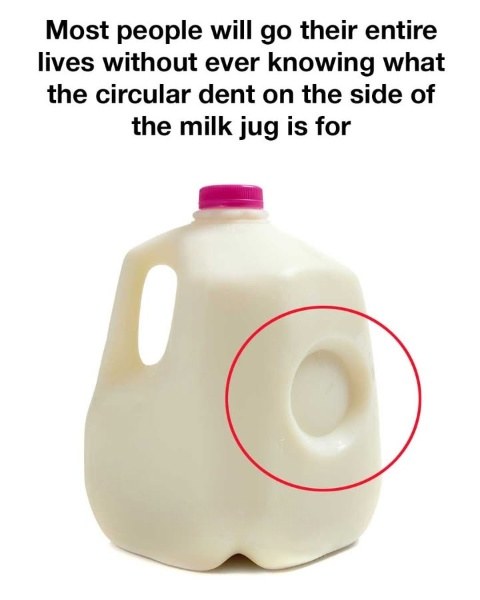Most people have noticed that odd circular dent on the side of a plastic milk jug and wondered what it’s doing there. It might seem like a manufacturing mistake or just a random design choice nobody gave much thought to. But that small indentation actually has a purpose — a smart, intentional one — and once you understand it, you’ll never look at a milk jug the same way again.
Think of it as the jug’s built-in safety system. It’s not decorative, and it’s not accidental. It’s engineering quietly at work while you’re just trying to pour cereal.
The dent serves three main functions: it manages pressure, prevents spills, and strengthens the jug without using extra plastic. A simple idea with a big impact.
First, pressure management. Milk goes through many temperature changes on its journey to your fridge — warm loading docks, cooled trucks, cold storage rooms, grocery store shelves, and finally your refrigerator. Liquids expand and contract with temperature changes, and milk is no exception. Without a pressure-relief zone, a jug could swell, crack, or even burst if the liquid froze and expanded. The dent flexes outward when pressure rises and returns when things cool down. It acts as a buffer, letting the jug stretch without snapping.
Next, durability. Anyone who’s dropped a gallon of milk knows the mess it creates. The dent helps absorb shock if the jug is bumped or dropped during transport. It spreads the force across the surface instead of letting the jug crack instantly. Grocers and distributors handle milk in bulk, and a single crack can ruin an entire shipment. That tiny dent saves companies money and saves you from cleaning milk off your kitchen floor.
The third function is structural integrity without extra plastic. Instead of making jugs thicker, manufacturers use shape to add strength — similar to how bridges and buildings use arches. The indentation makes the jug sturdier while keeping it lightweight and cheap to produce. Less plastic, same stability. It’s efficient, clever engineering — noticeable only when it fails.
Here’s another detail most people don’t know: the dent can act as an early warning system. Spoiling milk produces gas as bacteria multiply. If enough gas builds up inside the jug, the dent may bulge outward. When you open the fridge, a puffed-out or unusually expanded dent is a red flag. It doesn’t always mean the milk is bad, but it’s a strong hint to check before pouring. The dent gives away souring milk before the smell even hits.
Why is the indentation circular? Circles handle pressure better than squares or triangles. They distribute stress evenly, making them ideal for flexible areas. Corners create weak points; circles don’t. Circles are also easier and more consistent to mold in manufacturing. The result: a pressure plate that flexes evenly without cracking.
Once you notice the dent, you might start spotting other clever design choices in a milk jug. The handle isn’t just for grip — reducing plastic there saves material while keeping the jug comfortable. The ridges on the bottom help the jug sit evenly, even on uneven surfaces. Cap colors often indicate fat content: red for whole, blue for 2%, green for skim, and so on. The jug you take for granted is actually a masterclass in efficient, functional design hiding in plain sight.
What seems like a cheap plastic container is actually a sophisticated piece of engineering — shaped by safety regulations, manufacturing costs, transportation demands, and consumer habits. A dent isn’t just a dent. It’s the jug’s pressure valve, shock absorber, reinforcement ring, and spoilage indicator, all in one.
Most people pour milk without thinking about any of this, half-asleep, aiming for their cereal bowl, unaware of the science built into the container. But that small design solves multiple problems simultaneously, quietly preventing spills, cracks, and bacterial gas build-up.
Next time you grab a milk jug, look at that circular indentation for what it really is: a clever piece of engineering keeping your kitchen cleaner, your milk fresher, and your jug intact from factory to fridge. Even the most ordinary objects are working harder than you realize — and the milk jug dent is one of the simplest, smartest examples.
